Introduction
Cab aggregator is a new business concept in India. Today we have Ola, Uber, Taxi for Sure etc. which not only compete to provide better service to customers but also design more consumer friendly price structures. Gone are the days, when your trip cost only depended on the number of kilometers. Today it depends on a number of factors making it confusing enough to puzzle customers and the drivers. Here are a few charges you might see on your hired taxi’s invoice :
- Base Fare : Initial amount billed to sit in a cab
- Excess km fare : Billed amount on distance after complimentary ride
- Time fare : Billing on the time spent in the cab
- Minimum fare: This is the minimum amount you will be billed
- Tolls and excess fee : This is the excess charge you need to pay to compensate for the long distances outside main city
- Taxes : Taxes is are over and above the bill
- Premium multiplier : In crowded/congested time, you will be bill something like 1.4 – 2.5 X of the actual bill amount.
You see ? Undoubtedly, travelling in India has become a lot convenient. But, the companies have found subtle ways to get compensated well. Now, imagine comparing these taxi services with all these components together. Can we make this puzzle easier for Bengaluru, India population ? Let’s crack this puzzle for once and for all.
In this article, we’ll solve a case study of taxi aggregators. Along side, I’ll also focus on the essentials required for solving a case like a pro. Specially, consultant firms like Bain, BCG, McKinsey prefer candidates who think like a pro in solving any case study. Let’s make you one.
Disclaimer: This case is a hypothetical scenario associated with the popular brand names. The intention is to let people relate the importance of this case study in real life. We do not intend to promote / besmirch any brand.
You should also check out the ‘Ace Data Science Interviews‘ course if you’re struggling to land your first data science job! The course has been curated by experts who has conducted hundreds of interviews and includes multiple resources including the most comprehensive interview guide!

Why is structured thinking key to success in any case study?
Always remember, playing with structured thinking in any case study will put you at the front foot (dominant
 position). The technique of structured thinking is beneficial in many ways such as:
position). The technique of structured thinking is beneficial in many ways such as:
- It helps you to understand & solve the problem quickly as compared to any other traditional approach.
- It allows you to put a framework around unstructured problem.
- The framework allows you to explore the hidden aspects of the problem which might get neglected otherwise.
- Recruiters don’t look for exact answers from the case study, but the thought process used by a candidate in solving that problem. A structured thought process is well appreciated by recruiters around the world.
Now, you have the weapon. The questions are below. Let’s get ready!
Resources to improve your Structured Thinking
If you’ve trembled at the thought of ‘structured thinking’, don’t worry! There are numerous ways using which you can build and improve this skill. It’s easy to build but difficult to master. With time and practice, that can also be achieved. I was terrible at solving case studies until few years back. But, I patiently worked towards it and became better with time.
Here are few useful resources to build structured thinking:
- Practice Case Study – Part I
- Practice Case Study – Part II
- Case Study -Interesting Approach
- Strategic Thinking -Practice Problem (If you score more than 25, you are much better at structured thinking, than you think)
Basic parameters of Taxi Aggregators
In this case study, the taxi aggregator companies are selected from Indian markets. The currency used to denote travel fare is INR (Indian National Rupee). For people outside India, if you face any difficulty in understanding the severity of the travel fare, simply divide the fare by your currency’s conversion rate to get travel fare in your currency.
There are four categories of taxis:
- Micro : Super small taxi like Nano/E2O etc.
- Mini : These are hatchback options like Tata Indica.
- Sedan : These are Sedan options like Toyota Etios.
- Luxury : These are super luxurious cab options like Mercedes, BMW etc
Here are the taxi service providers you need to consider :
Aggregator 1
Ola: They have three category for Taxis : 1. Micro , 2. Mini , 3. Prime
In addition to this, minimum fare of Micro is fixed at Rs. 50.
Aggregator 2
Taxi For Sure: They also have 3 categories of Taxis as shown:
Aggregator 3
- Uber: It does not have a micro option but has a luxury as well called XL in addition to mini and sedan.
Questions
- Which of the MICRO vehicles will be cheapest if your distance lies between 1 to 8 kms?
- Which MINI vehicles are the cheapest if your distance is between 1 to 10 kms?
- If you get a free upgrade from Ola Micro to Mini, will it be cheaper than Uber Mini for distance 2-6 kms?
- Uber is charging a muliplier of 2.1 and Ola is charging a multiplier of 1.4 on their Sedan Vehicles (Ola Prime vs. UBER X). Which one will cost less ?
- You have already booked UberGo for a multiplier of 1.5 and now you are getting a Ola Mini vehicle without peak charges? The challenge is that if you cancel an Uber you will incur a cancellation charge penalty. However, if you choose to cancel, you stand a chance to save on peak charges for Uber. At what distance will you break even on the cancellation charges on Uber, in case you choose to go ahead with Ola?
Assumptions
- For all trips assume that every km journey will be completed in 4.5 minutes.
- No toll to be assumed in all the trips.
- No Taxes are applied for simplicity.
- Multipliers are applied on final bill amount.
- Cancellation charges can not be waived off if the booking has been made.
How to approach this case study?
Before you rush to answer section, think!
 Try to find out your way of solving this case. This phase is known as “approaching the problem”. It requires complete understanding of the problem. Considering the fact that this case has too many numbers, it will be a good practice to check their trend. This will help you to analyze taxis fare much faster.
Try to find out your way of solving this case. This phase is known as “approaching the problem”. It requires complete understanding of the problem. Considering the fact that this case has too many numbers, it will be a good practice to check their trend. This will help you to analyze taxis fare much faster.
Using structured thinking, break the problem into 3 sections (one for each taxi class). Now, look for trends within each taxi type. Always keep the questions asked in mind. This gives you an aim to target. Once you start digging for answers, it becomes much easier to know where to stop!
Answers
Which of the MICRO vehicles will be cheapest if your distance lies between 1 to 8 kms?
1 . Only Ola and Taxi for sure have the option of taxi type Micro. So, if we compare the two in the given distance range, TFS (Taxi For Sure) starts lower and crosses Ola at 4 km. Beyond 4 km Ola comes out to be cheaper. The answer will be cannot be determined in the distance range.
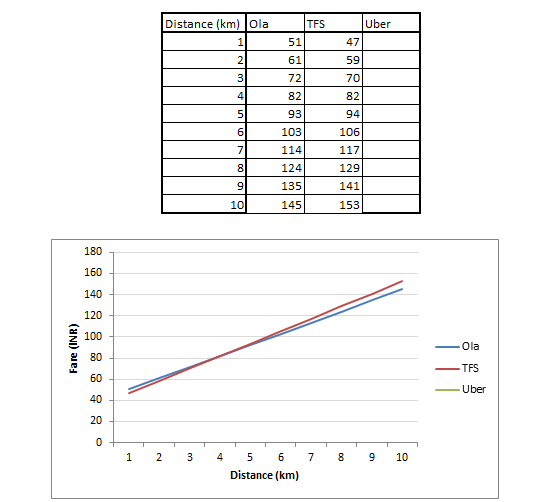 Which MINI vehicles are the cheapest if your distance is between 1 to 10 kms?
Which MINI vehicles are the cheapest if your distance is between 1 to 10 kms?
2. All the three taxi aggregators have option for Mini taxi. We clearly see that Uber is the cheapest car for the distance range and also seem to be the cheapest option for distances beyond 10 km looking at the trend.
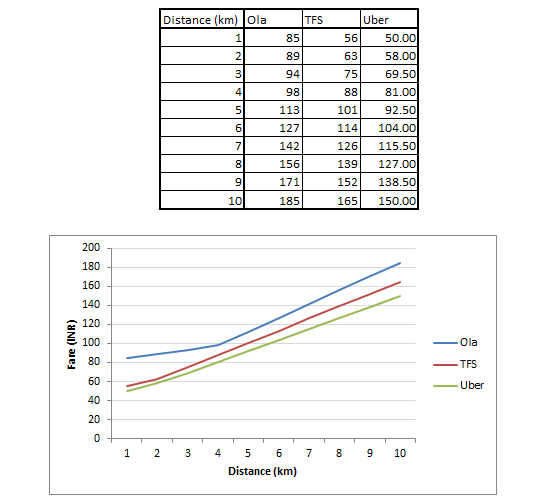 If you get a free upgrade from Ola Micro to Mini, will it be cheaper than Uber Mini for distance 2-6 kms?
If you get a free upgrade from Ola Micro to Mini, will it be cheaper than Uber Mini for distance 2-6 kms?
3. Free upgrade is a common scenario in Ola from Micro to Mini. So, this is a very relevant question to ask. The trend looks to be very interesting. Uber Go starts at a slightly lower rate than Ola Micro but Ola takes over after 5 km distance. So, again our answer will be cannot be determined in the distance range. However, it is interesting to notice that a Ola Micro taxi comes out to be more expensive than Uber Mini car for shorter than 5 km distance.
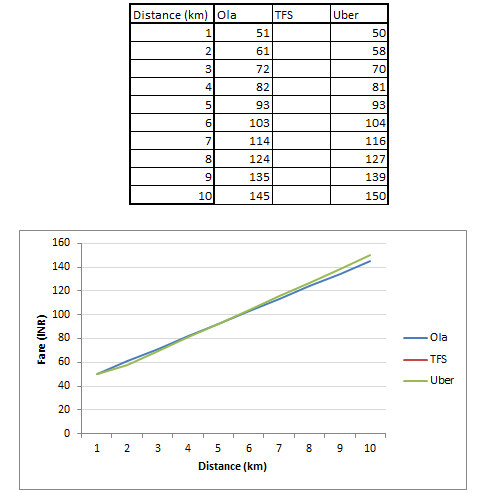 Uber is charging a muliplier of 2.1 and Ola is charging a multiplier of 1.4 on their Sedan Vehicles (Ola Prime vs. UBER X). Which one will cost less ?
Uber is charging a muliplier of 2.1 and Ola is charging a multiplier of 1.4 on their Sedan Vehicles (Ola Prime vs. UBER X). Which one will cost less ?
4. Multipliers are often added in peak traffic hours. It becomes very difficult to compare rates in such cases. Here’s one of those scenarios. Ola is generally more expensive compared to Uber, but in such extreme multiplier cases, we see that Ola comes out to be cheaper option throughout.
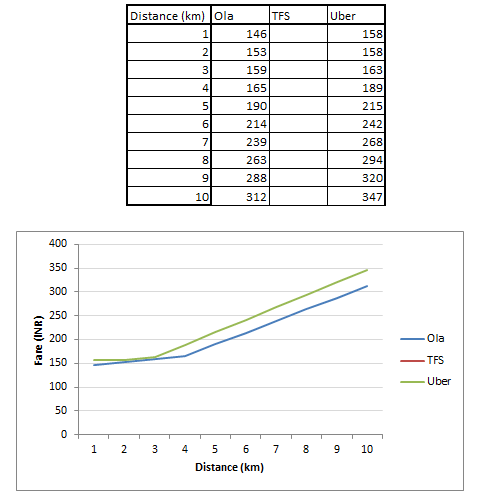 You have already booked UberGo for a multiplier of 1.5 and now you are getting a Ola Mini vehicle without peak charges? The challenge is that if you cancel an Uber you will incur a cancellation charge penalty. However, if you choose to cancel, you stand a chance to save on peak charges for Uber. At what distance will you break even on the cancellation charges on Uber, in case you choose to go ahead with Ola?
You have already booked UberGo for a multiplier of 1.5 and now you are getting a Ola Mini vehicle without peak charges? The challenge is that if you cancel an Uber you will incur a cancellation charge penalty. However, if you choose to cancel, you stand a chance to save on peak charges for Uber. At what distance will you break even on the cancellation charges on Uber, in case you choose to go ahead with Ola?
5. What you need to keep in mind is the cancellation charges of UBER. Here is the table for OLA vs. UBER :
As can be seen from both table and the graph, the break even only happens between 13-14 kms. Hence, you should make a switch only if you want to travel more than 13 kms.
End Notes
This was a fun exercise and hopefully useful for Indian population, who are confused with which cab service to take. You can expect such realistic case study in your interviews which might break many myths you had about the subject. For instance, before doing this analysis, I always assumed OLA Micro is the cheapest available option for all distances. However, looks like UBER Mini can be cheaper than OLA micro for smaller distance.
Did you like reading this article ? Have you encountered any such case studies in your interview? Do share your experience / suggestions in the comments section below.


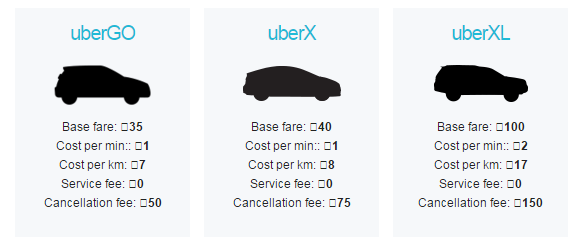
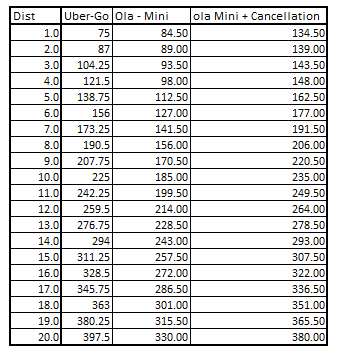
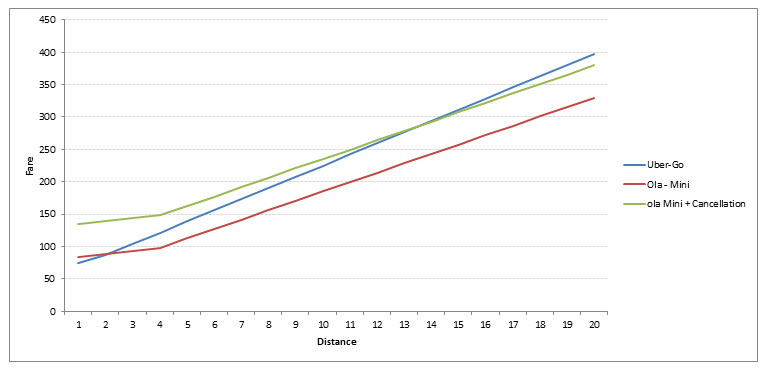



Hi Tavish, A very interesting case study. I have a small query. In the text it is mentioned that Uber does not have a MINI service.But in the solution part of the article, it is been considered as Uber does not have a micro taxi service but has a mini taxi service available. Which is the correct assumption?? In case Uber has a micro service then UberGo will be a better service compared to Ola or Taxi For Sure.
Uber doesn't have a micro option. Article has been corrected.
Hi Tavish Nice article.I was trying to derive the solution part of question 2 for the Mini for UBER X. There is Minimum KM that can be used to travel with the Minimum fare. I am unable to arrive at the values for uber which you shared in the solution. Can you please help me with that part alone of uber calculation.
This is very simple solution. A better approach should have how these companies analytically reach to a consensus that only these parameters are included in the calculation part. Just a thought. Regards, Shivi